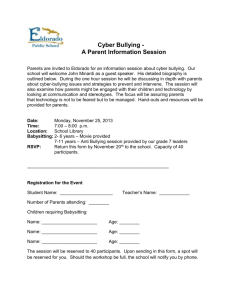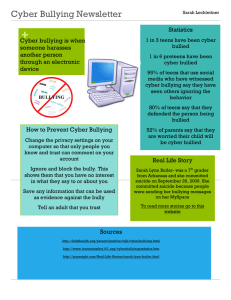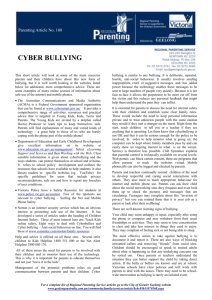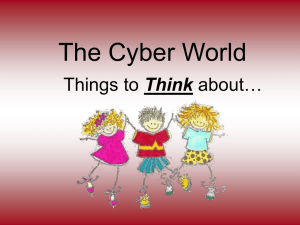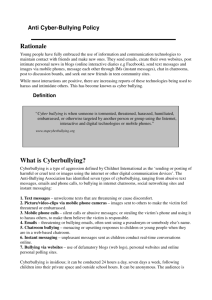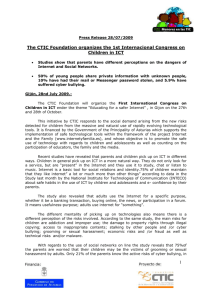Cyber Bullying - BU Blogs
advertisement
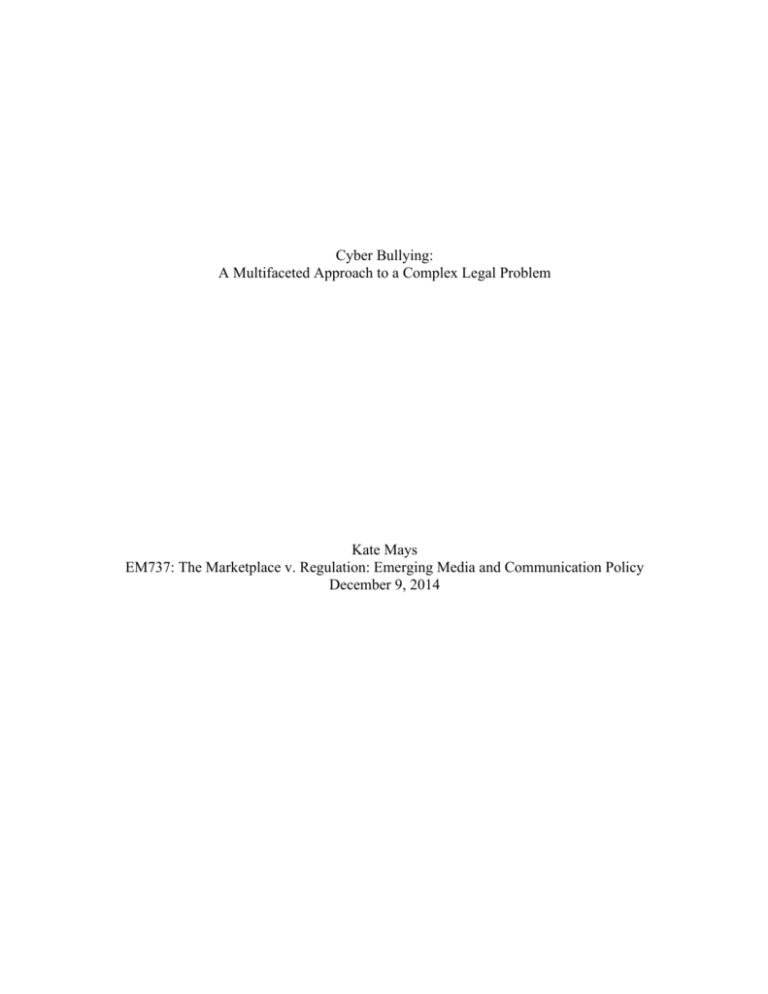
Cyber Bullying: A Multifaceted Approach to a Complex Legal Problem Kate Mays EM737: The Marketplace v. Regulation: Emerging Media and Communication Policy December 9, 2014 2 In 2006, 13-year-old Megan Meier struck up an online flirtation with a 16-year- old boy named Josh Evans. They messaged over the social networking site MySpace for about a month before Josh Evans suddenly turned on her, making nasty comments to Meier; in his final message to her, he said that “the world would be a better place without you.”1 On that same day Meier hanged herself. Six weeks later, Meier’s parents learned that Josh Evans didn’t exist.2 His MySpace profile had been created by 47-year-old Lori Drew, in concert with her daughter (a former friend of Meier’s) and her employee, to “learn what [Meier] was saying about Drew’s daughter online.”3 Despite the ensuing outrage and pressure the St. Charles County officials received to charge Drew with a crime, there was little legal recourse; at the time there were no statutes in Missouri or federally with which to charge Drew.4 Ultimately, federal prosecutors charged Drew under the Computer Fraud and Abuse Act for violating MySpace’s terms and services agreement,5 in an attempt to charge her with something. The Meier case is an extreme example of cyber bullying’s consequences, and not a very accurate one; Meier had suffered from depression, and so was already particularly 1. Christopher Maag. “A Hoax Turned Fatal Draws Anger but No Charges,” New York Times, November 28, 2007, http://www.nytimes.com/2007/11/28/us/28hoax.html?_r=0. 2. Ibid. 3. Kim Zetter. “Judge Acquits Lori Drew in Cyberbullying Case, Overrules Jury,” Wired.com, July 2, 2009, http://www.wired.com/2009/07/drew_court/. 4. Ibid. 5. Ibid. 3 vulnerable.6 Nevertheless, the case did raise awareness about cyber bullying, and in 2009 Rep. Linda Sanchez (D-California) proposed the “Megan Meier Cyber Bullying Prevention Act,” legislation that was intended to target the online nature of the harassment that allegedly prompted Meier’s suicide.7 Introduced to the House Judiciary’s Subcommittee on Crime, Terrorism, and Homeland Security, Sanchez’s proposal was met by skepticism by other committee members, whose concerns included infringement on free speech and that the legislation’s overly broad language could lead to overcriminalization.8 Sanchez’s proposal never made it beyond the subcommittee hearings,9 and the subcommittee’s apprehension of the legislation’s potential consequences underscores the difficulty in regulating a nebulous concept like cyber bullying: in what way should cyber bullying be defined, and what is the balance between protecting cyber bullying victims while protecting the free speech rights of the perpetrators? Online Harassment and Cyber Bullying: A brief review Online harassment is an umbrella term for various kinds of cyber harassment, including cyber stalking and cyber bullying, and can include “threats of violence, privacy 6. Jennifer Steinhauer, “Arguments in Case Involving Net and Suicide,” New York Times, November 19, 2008, http://www.nytimes.com/2008/11/20/us/20myspace.html. 7. David Kravets. “Cyberbullying Bill Gets Chilly Reception,” Wired.com, September 20, 2009, http://www.wired.com/2009/09/cyberbullyingbill. 8. Ibid. 9. “Megan Meier Cyberbullying Prevention Act,” Federal–Cyberbullying, accessed December 1, 2014, http://www.unc.edu/courses/2010spring/law/357c/001/Cyberbully/federal.html. 4 invasions, reputation-harming lies, calls for strangers to physically harm victims, and technological attacks.”10 Sometimes also termed “cyber victimization,”11 online harassment generally refers to “the intentional infliction of substantial emotional distress”12 through online speech and a series of incidents, not an isolated event, such that the actions can be considered a “course of conduct.”13 This paper distinguishes cyber bullying as online harassment among underage peers and usually involves schools, which will be discussed in greater detail below. Bullying is not a new concept, and has been considered a fairly typical, though unfortunate, part of growing up for some people.14 The additional technological components of cyber bullying, however, make the problem of peer harassment more acute. Whereas pre-Internet bullied students could find refuge away from school,15 today’s bullying is more pervasive, following students wherever they go through the myriad-networked devices that are becoming more central in teenagers’ lives. An abusive message may be shouted in the school cafeteria, then repeated through a Facebook post, 10. Danielle Citron, Hate Crimes in Cyberspace (Cambridge: Harvard University Press, 2014), 3. 11. Jacqueline D Lipton, “Combating Cyber-Victimization,” Berkeley Technology Law Journal, no. 2 (2011): 1103. 12. Citron, Hate Crimes in Cyberspace, 3. 13. Ibid. 14. Todd D. Erb, “A Case for Strengthening School District Jurisdiction to Punish OffCampus Incidents of Cyberbullying.” Arizona State Law Journal, no. 1 (2008), 259. 15. Wanda Cassidy, Chantal Faucher, Margaret Jackson, “Cyberbullying among youth: A Comprehensive review of current international research and its implications and application to policy and practice,” School Psychology International, no. 6 (2013), 580. 5 and circulated online through re-postings and comments. When a student is beaten up, the beating may be recorded by someone’s smartphone, and that video could be posted online and sent to friends, who share the video with their friends. In these hypothetical scenarios, the audience of the abuse can potentially become much larger, intensifying the bullied student’s feelings of humiliation and isolation, and expanding the opportunities for re-victimization.16 In sum, technology enables wider, more permanent dissemination of abuse. Furthermore, the Internet allows bullies to remain anonymous should they so choose, which makes it more difficult to identify the perpetrators. Danielle Citron, who has written extensively on cyber stalking and online harassment more broadly, coined the term “Hate 3.0” to reflect the current technological development and capacities of the Internet and thus the “personalized,” individuallydirected nature of online hate.17 Compounding this, technology enables users to “disaggregate” their ideas from their physical presence, which also removes social context from their online actions and can make it more difficult to discern the off-line intent and severity of the abuse.18 The Internet also eliminates geographical restrictions; this “aggregate” quality enables “cyber mobs” to form and attack less powerful individuals or groups.”19 16. Cassidy, “Cyberbullying among Youth,” 580. 17. Citron, Hate Crimes in Cyberspace, 13. 18. Danielle Citron, “Cyber Civil Rights,” Boston University Law Review, no. 1 (2009), 63. 19. Ibid, 66. 6 In a review of studies examining the psychological impacts of cyber bullying, Cassidy found that while a majority of cyber bullying occurs outside of school, it is connected to school-related incidents.20 Research has also shown that the online-specific aspects of cyber bullying – anonymity and wider dissemination of abuse – can intensify the deleterious effects of bullying.21 Cyber bullying research, as well as high-profile cases like that of Meier and Phoebe Prince,22 whose suicides have been connected to bullying, have garnered national attention and prompted calls for legal solutions to the problem. However, a legal solution is not as simple as enacting sweeping federal legislation to ban cyber bullying. As mentioned above, Rep. Linda Sanchez already tried to propose such legislation, and it failed to go anywhere.23 Academics and legal scholars have identified two general areas of recourse to combat cyber bullying: school sanctions and legal remedies, either through criminal charges or civil suits. This paper will address both areas, through an examination of the two main obstacles and concerns in any cyber bullying case: the first amendment and defining the key terms of cyber bullying cases. A larger focus is given to schools’ actions around cyber bullying, as most cases of cyber bullying exist somewhere between students’ lives inside and outside of school. Cyber Bullying and Free Speech Concerns 20. Cassidy, “Cyberbullying among Youth,” 581-582. 21. Ibid. 22. Emily Bazelon, “What Really Happened to Phoebe Prince? The untold story of her suicide and the role of the kids who have been criminally charged for it,” Slate.com, July 20, 2010, http://img.slate.com/media/31/100721_Bull-E_final_3.pdf. 23. Kravets, “Cyberbullying Bill Gets Chilly Reception.” 7 The Supreme Court established the country’s commitment to an unfettered public discourse in New York Times v. Sullivan.24 Courts have followed this precedent and “consistently held that the First Amendment generally forbids restrictions of speech in public discourse on the ground that it is offensive, unsettling, insulting, demeaning, annoying, snarling, bilious, rude, abusive, or nasty.”25 In other words, most speech is constitutionally protected regardless of how unsavory it might be. Unprotected speech, which the government can regulate, falls into a narrower category that includes “fighting words, true threats, incitement, and obscenity.”26 Federal legislation aimed at protecting minors through widespread regulation of Internet content has yet to pass,27 though not for lack of trying. Specifically, Congress tried twice to pass legislation protecting children from sexually explicit content on the Internet:28 the Communications Decency Act (CDA) in 1996, and the Children’s Online Protection Act (COPA) soon after the CDA’s failure.29 Both pieces of legislation were struck down as unconstitutional for infringing on First Amendment rights. While the 24. Geoffrey Stone, “Privacy, the First Amendment, and the Internet,” in Offensive Internet: Speech, Privacy, and Reputation, ed. Saul Levmore and Martha C. Nussbaum, (Cambridge: Harvard University press, 2010), 174. 25. Ibid. 26. Benjamin L. Ellison, “More Connection, Less Protection? Off-Campus Speech with On-Campus Impact,” Notre Dame Law Review, no. 2 (2010), 814. 27. Steven E. Merlis, “Preserving Internet Expression While Protecting Our Children: Solutions Following Ashcroft v. ACLU,” Northwestern Journal of Technology and Intellectual Property, no. 1 (Fall 2005), 125. 28. Ibid, 119. 29. Ibid, 121-122. 8 Court agreed that both served a compelling government interest – the first test of strict scrutiny – it found that neither was narrowly tailored enough.30 Two items from the legal history of CDA and COPA are important to consider. First, both acts addressed a fairly specific concern: exposing children to sexually explicit content over the Internet. This is not only much more targeted than the broad swath of actions and content encompassed by cyber bullying, but also arguably a more critically compelling governmental interest. Second, COPA was drafted by Congress to address the deficiencies identified in CDA, which the Court recognized, but it still determined that COPA was too broad and therefore infringed too substantially on free speech to be constitutional.31 The history of CDA and COPA indicates that the Court is highly skeptical of Internet regulation and its potential chilling effect on speech. Given this precedent, Merlis asserts that “society should look at other options to find a way to protect children while maintaining the integrity of the First Amendment.”32 After the public outcry over Meier’s suicide, states began passing legislation to address bullying.33 Currently, 49 states have 30. Ibid, 123. 31. Ibid. 32. Ibid, 125. 33. John O. Hayward, “Anti-Cyber Bullying Statues Threat to Student Free Speech,” Cleveland State Law Review, no. 1 (2011), 87. 9 enacted anti-bullying laws and 48 include mention of electronic harassment; only 20 statutes explicitly include the term “cyber bullying.”34 Additionally, 44 of the 49 anti-bullying statutes include school sanctions, which grant schools the authority to discipline students for bullying behavior.35 It stands to reason that cyber bullying, which occurs between peers, would largely revolve around school life. The following section evaluates how schools and the courts have handled student speech issues broadly, which has established a precedent for approaching students’ speech in cases of cyber bullying. Cyber Bullying and School Sanctions Scholars point to three cases that define the legal standards for student speech at school: Tinker v. Des Moines Independent School District; Bethel School District No. 43 v. Fraser; and Hazelwood School District v. Kuhlmeier.36 In Tinker, students were suspended for wearing black armbands to school to protest the Vietnam War.37 The Supreme Court affirmed the students’ rights to political speech in school, noting that students do not “shed their constitutional rights to freedom of speech or expression at the 34. Sameer Hinduja and Justin W. Patchin, “State Cyberbullying Laws: A Brief Review of State Cyberbullying Laws and Policies,” Cyberbullying Research Center, updated September 2014, http://www.cyberbullying.us/Bullying_and_Cyberbullying_Laws.pdf. 35. Ibid. 36. Renee L. Servance, “Cyberbullying, Cyber-Harassment, and the Conflict Between Schools and the First Amendment,” Wisconsin Law Review, no. 6 (2003), 1224. 37. Christine Metteer Lorillard. “When Children’s Rights ‘Collide’: Free Speech vs. The Right to be Let Alone in the Context of Off-Campus ‘Cyber-Bullying,’” Mississippi Law Journal, no. 2 (2011), 208. 10 schoolhouse gate.”38 The Court affirmed that students had a right to free speech provided it did not cause or “forecast a substantial disruption of or material interference with school activities”39 or “collid[e] with the rights of others.”40 The Court established in Bethel that schools could restrict speech that “would undermine the school’s basic educational mission.”41 In this case, a student (Fraser) gave a lewd and vulgar schoolwide speech; although the speech did not “substantially or materially interfere” with school activities, as laid out in Tinker,42 the Court reasoned that schools could censor speech in the interest of “promoting civility and citizenship.”43 In the third case, Hazelwood, the Court determined that schools had greater control of student speech expressed through school-sponsored activities using school resources.44 This “legal triumvirate”45 establishes a few important standards that affect schools’ authority to sanction cyber bullies: in order for schools to restrict speech, it 38. Tinker v. Des Moines Independent Community School District (No. 21). 393 U.S. 503, 506 (1969), http://www.law.cornell.edu/supremecourt/text/393/503. 39. Ibid, 514. 40. Tinker v. Des Moines Independent Community School District, in Lorillard, “When Children’s Rights ‘Collide,’” 209. 41. Bethel School District No. 43 v. Fraser, in Lorillard, “When Children’s Rights ‘Collide,’” 211. 42. Lorillard, “When Children’s Rights ‘Collide,’” 209. 43. Samuel C. McQuade III, James P. Colt, Nancy B.B. Meyer, Cyber Bullying: Protecting Kids and Adults from Online Bullies, (Westport, Connecticut: Praeger, 2009), 102. 44. Servance, “Cyberbullying, Cyber-Harassment, and the Conflict Between Schools and the First Amendment,” 1229. 45. Ibid, 1224. 11 should occur within school grounds, be either lewd and/or vulgar or substantially disrupt school activities, or be expressed using school resources, such that the school is implicated in the expression. Although Tinker, Bethel, and Hazelwood are all analog cases, occurring before the Internet, the established standards have been applied to cases involving students’ online speech with mixed results. In a synthesis of the first 11 cases that have addressed students’ “cyber expression,” Lorillard notes that in each the speech is directed towards the schools, teachers, or administrators;46 it is worthwhile to consider whether the inherent power imbalance between bully (student) and victim (adult) reduces the impact and seriousness of the offending speech. In six of these cases the courts found that the schools had violated students’ free speech rights based on a variety of factors including the content of the speech, how targeted it was, and whether it had or was intended to reach school.47 The first case involving student-on-student bullying occurred in 2009.48 J. C. ex rel. R. C. v. Beverly Hills Unified School District dealt with a student (J.C.) who recorded herself and her friends “maligning” another classmate (C.C.).49 J.C. posted the video on YouTube and shared it with a few friends and by the evening the video had been viewed 46. Lorillard, “When Children’s Rights ‘Collide,’” 247. 47. Ibid, 245. 48. Ibid, 247. 49. Ibid. 12 90 times.50 The subject of the video, C.C., brought the school’s attention to the video and spent 20-25 minutes talking to a school counselor because she “felt humiliated”;51 ultimately she missed part of one class.52 The Court determined that it could apply Tinker to the case because even though the speech originated outside of school grounds, the video’s content “increase[d] the likelihood that the expression [would] reach campus,”53 and so there was a sufficient connection between the “off-campus” speech and the school environment. However, in applying Tinker, the Court ultimately rejected the contention that J.C.’s video had caused a “substantial disruption.”54 The problem of defining what constitutes a “substantial disruption” will be discussed in greater detail below, but the J.C. case also raises the important question of how students’ free speech rights should be considered in balance to other students’ rights to privacy and a peaceful learning environment. When Tinker is invoked in most of the cyber bullying cases mentioned above, attention is primarily paid to the “substantial disruption” part of the decision. In the excerpted quotation from Tinker that follows, though, “invasion of the rights of other” appears equally prominently: But conduct by the student, in class or out of it, which for any reason – whether it stems from time, place, or type of behavior – materially disrupts classwork or 50. Ibid. 51. Ibid, 248. 52. Ibid. 53. Ibid, 250. 54 Ibid, 248. 13 involves substantial disorder or invasion of the rights of others is, of course, not immunized by the constitutional guarantee of freedom of speech.55 As mentioned earlier, the six decisions reviewed by Lorillard that upheld the students’ speech rights could not find a substantial enough disruption to merit restricting the students’ speech.56 It seems possible, however, that a court could use the second half of the Tinker standard, speech that is an “invasion of the rights of others,” along with the Bethel standard – that schools have the right to restrict speech that is “contrary to the school’s educational objectives”57 – to give schools more latitude to address cyber bullying. Indeed, Servance points to the school’s authority recognized by the Court in Bethel to “decide what constitutes inappropriate conduct and expression within the school” and balance “the right to free speech with the goal of protecting the rights of others where speech causes harm.”58 McCarthy asserts that a fourth case addressing student speech, Morse v. Frederick, supports the use of other standards “beyond Tinker’s disruption prong … to assess the constitutionality of student expression.”59 In Morse, the school sanctioned a student for speech that technically occurred outside school grounds.60 55. Tinker v. Des Moines Independent Community School District, 513. 56. Lorillard, “When Children’s Rights ‘Collide,’” 246. 57. Erb, “A Case for Strengthening School District Jurisdiction,” 262. 58. Servance, “Cyberbullying, Cyber-Harassment, and the Conflict Between Schools and the First Amendment,” 1229. 59. Martha McCarthy, “Curtailing Degrading Student Expression: Is a Link to a Disruption Required?” Journal of Law & Education, no. 4 (2009), 611. 60. Erb, “A Case for Strengthening School District Jurisdiction,” 263. 14 In this case, a student held up a large banner that espoused drug use; ultimately, the Court affirmed the school’s right to discipline the student because the student’s message supported illegal activity and was conveyed during a school-related activity.61 While this case technically affirmed a school’s authority to restrict speech off campus, the decision is narrowly interpreted to apply only to messages that promote illegal drug use,62 and therefore doesn’t apply in the majority of cyber bullying cases.63 Lorillard describes Morse as the first decision that involves the “‘content-based regulation’ of student speech.”64 McCarthy argues further that the Morse standard obviates the Tinker disruption requirement and therefore, when combined with the second lesser-used standard in Tinker allowing for restriction of speech that invades others’ rights, could reasonably expand schools’ authority to sanction speech that harms individual students or groups.65 The distinction between “on campus” versus “off campus” speech that arose in Morse is a more significant issue with cyber bullying. In both Bethel and Tinker, the speech being addressed clearly occurred on school grounds and is therefore more liable to restriction. As will be discussed further below, the Internet confounds the clear division 61. Raul R. Calvoz, Bradley W. Davis, Mark A. Gooden, “Cyber Bullying and Free Speech: Striking an Age-Appropriate Balance.” Cleveland State Law Review, no. 2, (2013), 377. 62. Ibid. 63. Erb, “A Case for Strengthening School District Jurisdiction,” 263. 64. Lorillard, “When Children’s Rights ‘Collide,’” 240. 65. McCarthy, “Curtailing Degrading Student Expression,” 611. 15 between speech that technically occurs outside of school but makes its way inside the “schoolhouse gate.” It should be noted, too, that the Tinker decision involved political speech. Citron and others have asserted that it’s not uncommon for online harassment to reach the level of “low value” speech, like defamation and true threats, which is not constitutionally protected and therefore should be more aggressively regulated.66,67 In these cases, schools more clearly have the authority to intervene and sanction students’ speech, including offcampus speech that is “clearly threatening to students or staff and therefore disruptive to the learning environment and educational process.”68 There is still, however, the issue of how to determine whether speech constitutes defamation or true threats. The Supreme Court is currently hearing a case, Elonis v. United States, which addresses threats expressed over the Internet. At issue is whether “true threats” made online should be determined by whether the speaker intends for the content to be threatening, or whether a “reasonable person” might interpret the content as truly threatening.69 This paper is not going to delve into the intricacies of the Elonis case and defining true threats, but the Supreme Court’s decision might have significant implications for addressing cyber bullying. Determining a true threat based on a 66. Citron, Hate Crimes in Cyberspace, 190. 67. Calvoz, “Cyber Bullying and Free Speech: Striking an Age-Appropriate Balance,” 380-381. 68. Sameer Hinduja and Justin W. Patchin. “Cyberbullying: A Review of the Legal Issues Facing Educators,” Preventing School Failure, no. 2 (2011), 74. 69. Lyle Denniston, “Argument Preview: Social media as a crime scene,” SCOTUSblog.com, November 29, 2014, http://www.scotusblog.com/2014/11/argumentpreview-the-social-media-as-a-crime-scene/. 16 reasonable person’s interpretation would give schools more latitude to identify speech that affects an individual student as a true threat and therefore is unprotected. In most cases, however, speech that might cause a substantial disruption or invade on others’ rights at school will not rise to the level of unprotected speech. Defining Cyber Bullying and its Components At first glance, the precedents established by Tinker, Bethel, and Hazelwood seem to provide clear-cut guidelines for when a school can sanction a student for cyber bullying: when the bullying occurs on school grounds; causes a substantial disruption or contains lewd or offensive language that it subverts the school’s educational mission; or is accomplished through use of a school’s resources. These standards become more problematic, however, when defining what constitutes the various components in the above standards, particularly as they apply to online technology. In her synthesis of 11 cyber bullying cases, Lorillard found that most decisions primarily turned on whether speech could be considered “on campus” or “off campus,” and if so, whether it caused a “substantial disruption.” The following section will explore these definitional components. “On-campus” and “Off-campus” Speech According to the standard set by Tinker, students’ speech can only be legitimately restricted if it occurs within the school grounds.70 The geographically limitless and ubiquitous nature of the Internet, however, blurs the lines between “on campus” and “off 70. Tinker v. Des Moines Independent Community School District, 506. 17 campus.”71 Online attacks that are created on someone’s home computer can easily reach the school through its impact on the targeted student(s), and therefore the question becomes whether the school has a prerogative to regulate that speech, and to what extent. Lorillard refers to this phenomenon as an “on-campus ‘telepresence,’”72 and Dranoff proposes a three-part definition of on-campus speech to incorporate physicallypresent and tele-present speech: “(1) it actually takes place on campus; (2) it advocates on-campus action; or (3) a reasonable person would believe, given the circumstances, that the student intended for his speech to reach the school.”73 In this definition, Dranoff attempts to identify a “sufficient nexus”74,75 between on-campus and off-campus speech that would enable schools to address cyber bullying. Courts have tried to navigate the geographical limitation of the “on campus” distinction as it relates to cyber bullying through a few methods. First, if the speaker brings the offensive material to school (e.g., accesses a harassing website through school computers), courts have established that the speech has been brought “on campus.”76 Two 71. Servance, “Cyberbullying, Cyber-Harassment, and the Conflict Between Schools and the First Amendment,” 1235. 72. Lorillard, “When Children’s Rights ‘Collide,’” 198. 73. Scott Dranoff, “Tinker-ing with Speech Categories: Solving the Off-Campus Student Speech Problem with a Categorical Approach and a Comprehensive Framework,” William and Mary Law Review, no. 2 (2013), 653. 74. Erb, “A Case for Strengthening School District Jurisdiction,” 264. 75. Calvoz, “Cyber Bullying and Free Speech: Striking an Age-Appropriate Balance,” 382. 76. Ellison, “More Connection, Less Protection?” 824. 18 other more tenuous standards77 include whether a student has knowledge that the offending material will be distributed during school or could “reasonably foresee” that the material would be brought to school.78 While these latter two categories attempt to more comprehensively define “on campus” speech as it relates to online content, they are still considerably vague and thus open to subjective interpretation. Servance proposes removing the “on-campus” versus “off-campus” consideration altogether, arguing that with the Internet, a geographical boundary is irrelevant: Because the geographic distinction fails to account for the difference in the medium and impact of speech on targeted members of the school community, it is not a reliable rule for determining the boundary of school authority.79 Servance argues that courts should give deference to schools, which “confront” daily the issue of “balanc[ing] the right to freedom of expression with the rights of others to be free from harassment.”80 Other scholars have argued that giving schools the kind of carte-blanche disciplinary authority that Servance suggests, which could easily reach into students’ conduct at home, subverts parents’ “fundamental right to direct the upbringing of their children.”81 For this reason, Raatjes advocates that, while schools still have authority to 77. Ibid, 825-26. 78. Ibid. 79. Servance, “Cyberbullying, Cyber-Harassment, and the Conflict Between Schools and the First Amendment,” 1215. 80. Ibid, 1238. 81. Laura Pavlik Raatjes, “School Discipline of Cyber-Bullies: A Proposed Threshold that Respects Constitutional Rights,” The John Marshall Law Review, no. 1 (2011), 103. 19 sanction significantly disruptive student behavior, there should be a high threshold in how a “substantial disruption” is defined.82 Substantial Disruption Whether or not speech causes a “substantial disruption” is a subjective determination. In a Comment addressing current legal approaches to cyber bullying, Erb laments what he perceives as the “unreasonably high ‘substantial disruption’ benchmark the Supreme Court has set”83 in evaluating schools’ sanctions against cyber bullies. According to Erb and others, and as seen in the case of J.C., an act of cyber bullying must disturb the school environment or affect “class activities,”84 not just be a “distraction or curiosity”85 to an individual or small group of students, to be considered a “substantial disruption.” Applying a more traditional, analog definition of “substantial disruption” risks ignoring the unique characteristics of cyber bullying. Given the “individualized,”86 targeted nature of cyber attacks, one student can be persistently and aggressively harassed over the Internet with barely a disruption to the school environment as a whole; the cyber victim’s learning environment, however, would be significantly disrupted.87 Erb is 82. Ibid, 104. 83. Erb, “A Case for Strengthening School District Jurisdiction,” 268. 84. Lorillard, “When Children’s Rights ‘Collide,’” 209. 85. Erb, “A Case for Strengthening School District Jurisdiction,” 266. 86. Ibid, 274. 87. Ibid. 20 concerned that past cases ignore the individual effects of cyber bullying in their applications of Tinker.88 On the other hand, loosely interpreting “substantial disruption” so that it applies to any kind of hurtful speech – depending on the receiver’s interpretation – could give schools too much latitude. Hayward is alarmed that “substantial disruption” and the other terms in anti-bullying statutes are “so vague that they offer no guidance to distinguish permissible from impermissible speech.”89 Particularly if schools apply “substantial disruption” to an individual’s learning environment, as Erb suggests, schools may sanction speech merely on the basis of “the way people react to it at school.”90 Applying the standard so indiscriminately could “create a ‘heckler’s veto’ situation”91 in which schools over-discipline merely objectionable speech, and chill students’ speech overall. Concerns for students’ well-being and free speech rights are both legitimate, and striking an appropriate balance will likely have to be determined on a case-by-case basis. Servance’s idea of an impact analysis could be useful here. Even though she was writing in 2003, when the cyber bullying cases involved only students’ speech directed towards the teachers, administrators, or schools, her proposed impact analysis boils down to whether the bully and targeted individual(s) are members of the same school community, and whether the bullying had a substantial or material negative affect on the targeted 88. Ibid. 89. Hayward, “Anti-Cyber Bullying Statues Threat to Student Free Speech,” 92. 90. Ibid, 91. 91. Dranoff, “Tinker-ing with Speech Categories,” 684. 21 individual.92 Servance defines this in practical terms as whether a teacher’s ability to teach or maintain classroom control was disrupted.93 Schools could apply this impact analysis to students to consider whether cyber bullying negatively affects their abilities to learn or participate fully in school life. Other Legal Remedies for Cyber Bullying Some legal scholars have argued that cyber bullies’ off-campus speech should be subject instead to civil and criminal laws rather than school sanctions, given the implications to students’ first amendment rights if schools are given jurisdictional freerein to restrict speech whether it occurs inside or outside of school.94 Others have pointed to regulatory solutions that target the websites themselves that enable the expression. Civil and Criminal law Victims of cyber bullying have recourse outside of school sanctions through both civil and criminal law.95 There are several areas under tort law under which a victim could sue his or her cyber bully: 1) defamation; 2) invasion of privacy; 3) intentional infliction of emotional distress; and 4) negligence in providing reasonable levels of supervision of a child.96 92. Servance, “Cyberbullying, Cyber-Harassment, and the Conflict Between Schools and the First Amendment,” 1239. 93. Ibid. 94. Raatjes, “School Discipline of Cyber-Bullies: A Proposed Threshold,” 104. 95. Ibid. 96. McQuade, Cyber Bullying: Protecting Kids and Adults from Online Bullies, 116. 22 Given the time and money usually required to sue someone, bringing a civil lawsuit against a cyber bully may not be the most realistic resolution.97 Citron also raises another concern, which is that some cyber victims may be reluctant to bring a lawsuit because they would be required to do so under their real names, thus potentially increasing attention and risking heightening the invective from their abusers.98 There is a similar resource limitation in addressing cyber bullying through law enforcement.99 Other cyber crimes such as child pornography, hacking, and cyber terrorism are perhaps a more significant concern for law enforcement.100 Further, as Erb points out, cyber-bullying speech may be nasty and offensive, but it “will rarely rise to the level of criminal or civil liability.”101 It seems reasonable, given the practical constraints of both civil and criminal recourse, as well as the higher stakes students would face,102 that the majority of cyber bullying cases would be more appropriately and efficiently addressed through school actions. Revising Section 230 of the Communications Decency Act So far this paper has addressed remedies to cyber bullying through school sanctions and legal responses, in which the onus is placed on the school authorities or the 97. Citron, Hate Crimes in Cyberspace, 122. 98. Ibid. 99. McQuade, Cyber Bullying, 115. 100. Ibid. 101. Erb, “A Case for Strengthening School District Jurisdiction,” 260. 102. Ibid, 284. 23 victims themselves to discipline or sue the cyber bully. Another possible solution, however, lies with the websites themselves through which cyber bullies perpetrate their abuse. Scholars have proposed that websites’ liability to address and take down bullying speech should be greater than the near-blanket immunity currently provided to websites under Section 230 of the Communications Decency Act (CDA).103,104,105 Section 230 was enacted to ensure that a website would not be held legally responsible for third-party comments,106 which serves the worthwhile purpose of promoting free speech; otherwise, liability concerns might induce websites to overly-regulate users’ comments and postings. However, website immunity introduces some challenges to the civil, criminal, and school-related remedies for cyber bullying discussed above. The Internet affords bullies anonymity, which can make it difficult to identify the source of the abuse beyond the webpage on which it’s posted. Levmore likens anonymous bullying on a webpage to an analog counterpart – an anonymous nasty comment written on a bathroom wall – with a few key differences: the audience of the bathroom wall is limited, the medium of the wall limits the scope and depth of the message, and “the greater the offense with respect to 103. Lipton, “Combating Cyber-Victimization,” 1132. 104. Nancy S. Kim, “Website Proprietorship and Online Harassment,” Utah Law Review, no. 3 (2009), 1033. 105. Daniel Solove, “Speech, Privacy, and Reputation on the Internet,” in Offensive Internet: Speech, Privacy, and Reputation, ed. Saul Levmore and Martha C. Nussbaum, (Cambridge: Harvard University press, 2010), 23. 106. Ibid. 24 both content and audience, the more quickly the communication will be erased.”107 With immunity, websites cannot be compelled to reveal a cyber bully’s identity or take down the offending content. Solove advocates a “notice-and-takedown” requirement similar to that found in the Digital Millennium Copyright Act (DMCA), which strips websites of their safe harbor protections once they’ve been notified of a copyright infringement.108 While he notes that the DMCA is “fraught with problems,”109 including significant abuse of the notice-and-takedown policy wherein wealthy, corporate entities intimidate non-copyright violators into removing content, Solove contends that requests for removal of defamatory or privacy-infringing content would come from individuals who lack similar litigation power.110 This distinction does not entirely address the concern that a notice-andtakedown requirement would result in “excessive” takedown and thus chill speech,111 and it would put websites in the position of determining whether content is actually “defamatory or otherwise tortious material.”112 In an early test of Section 230, Kenneth M. Zeran v. American Online, Incorporated, the Court unequivocally affirmed website immunity from liability for third 107. Saul Levmore, “The Internet’s Anonymity Problem,” in Offensive Internet: Speech, Privacy, and Reputation, ed. Saul Levmore and Martha C. Nussbaum, (Cambridge: Harvard University Press, 2010), 53. 108. Solove, “Speech, Privacy, and Reputation on the Internet,” 25. 109. Ibid. 110. Ibid, 26. 111. Ibid. 112. Kim, “Website Proprietorship and Online Harassment,” 1033. 25 party postings.113 Zeran brought action against AOL over defamatory content posted about him on one of AOL’s online bulletin boards by an unknown user. He claimed that AOL “unreasonably delayed in removing defamatory messages … refused to post retractions of those messages, and failed to screen for similar postings.”114 Ultimately the Court rejected Zeran’s argument that once AOL had been notified of the defamatory material, the interactive computer service was therefore liable for that content. In doing so it interpreted Congress’s intention in enacting Section 230 as follows: Congress recognized the threat that tort-based lawsuits post to freedom of speech in the new and burgeoning Internet medium. The imposition of tort liability on services providers to the communications of others represented, for Congress, simply another form of intrusive government regulation of speech. Section 230 was enacted, in part, to maintain the robust nature of Internet communication and, accordingly, to keep government interference in the medium to a minimum.115 The Court’s assertion of Internet independence with Zeran v. AOL back in 1997 is informative today when considering government regulatory interventions to address cyber bullying. The striking down of CDA and COPA, discussed earlier, as well as Section 230’s immunity provision, indicate that comprehensive federal regulations are not a viable solution in confronting cyber bullying. Conclusion 113. Kenneth M. Zeran v. America Online, Incorporated. (No. 97-1523). 129 F.3d 327 (1997), https://www.eff.org/files/zeran-v-aol.pdf. 114. Ibid, 328. 115. Ibid, 330 (emphasis added). 26 Technology is a significant new complicating factor to an old problem: bullying. The Internet has enabled bullying to occur at all hours of the day and reach its targets anywhere. This new facet has complicated traditional pre-Internet boundaries between conduct that occurs in school and outside of school, and therefore it is less clear when schools have the authority to discipline students for bullying. Further, the mediated aspect of cyber bullying means that all bullying actions are speech-related, which thus requires greater caution in attempts to restrict or discipline cyber bullying, such that they don’t infringe on first amendment rights. Merlis contends that in the advent and rapid rise of the Internet as “a vital part of Americans’ lives … legislators, parents, and the computer-technology industry failed to adequately prepare for the problems the Internet created.”116 Some have argued that the new Internet-related problem of cyber bullying should be addressed by federal legislation, while others are concerned that broad legislation would overreach and chill speech. So far the Courts have sided with the latter group, concerned with the breadth of the laws aimed at protecting children from Internet expression. States have enacted bullying laws, some of which include mention of electronic harassment specifically. As mentioned above, schools have also maintained varying levels of authority to discipline students who engage in cyber bullying. That authority, however, hinges on whether the speech occurs on- or off-campus and its impact on the school’s learning environment. Even if there weren’t free speech concerns related to disciplining cyber bullying, some scholars have noted that taking punitive action against a bully does not necessarily 116. Merlis, “Preserving Internet Expression While Protecting Our Children,” 131. 27 have the intended salubrious effect of protecting the victim or improving the situation.117 Instead, schools’ primary place might be in taking a proactive as well as remedial approach to cyber bullying. Raatjes lays out several non-disciplinary options, including: Internet safety training programs that would educate students on and promote responsible online behavior; diverting and/or productive after-school activities for students; and “parental training programs,” which might be done in partnership with local police departments.118 For school policy, a combined approach that first utilizes proactive and remediation measures, and if those fail to address the problem, then escalates to disciplinary action, might be most reasonable. It seems it would be easier to prove a substantial disruption if pre-disciplinary measures are taken; a persistent bully who then requires discipline has already shown a course of conduct that would be more disruptive than a one-time incident. This kind of mixed approach would also allow the kind of flexibility critical to issues around emerging media. As technology develops, the current methods for carrying out cyber bullying could very likely change, and so laws that are too prescriptive regarding what kinds of actions or expression are allowed might be not only too restrictive of speech, but also obsolete in a few years. 117. Raatjes, “School Discipline of Cyber-Bullies: A Proposed Threshold,” 114. 118. Ibid. 28 Bibliography Bazelon, Emily. “What Really Happened to Phoebe Prince? The untold story of her suicide and the role of the kids who have been criminally charged for it,” Slate.com, July 20, 2010, http://img.slate.com/media/31/100721_Bull-E_final_3.pdf. Calvoz, Raul R., Bradley W. Davis, Mark A. Gooden. “Cyber Bullying and Free Speech: Striking an Age-Appropriate Balance.” Cleveland State Law Review, no. 2 (2013): 35789. Cassidy Wanda, Chantal Faucher, Margaret Jackson. “Cyberbullying among Youth: A Comprehensive Review of Current International Research and Its Implications and Application to Policy and Practice.” School Psychology International, no. 6 (2013): 575612. Citron, Danielle. Hate Crimes in Cyberspace. Cambridge: Harvard University Press, 2014. Citron, Danielle Keats. “Cyber Civil Rights.” Boston University Law Review, no. 1 (2009): 61-125. Denniston, Lyle. “Argument Preview: Social media as a crime scene,” SCOTUSblog.com, November 29, 2014, http://www.scotusblog.com/2014/11/argumentpreview-the-social-media-as-a-crime-scene/. Dranoff, Scott. “Tinker-ing with Speech Categories: Solving the Off-Campus Student Speech Problem with a Categorical Approach and a Comprehensive Framework.” William and Mary Law Review, no. 2 (2013): 649-685. Ellison, Benjamin L. “More Connection, Less Protection? Off-Campus Speech with OnCampus Impact.” Notre Dame Law Review, no. 2 (2010): 809-848. Erb, Todd D. “A Case for Strengthening School District Jurisdiction to Punish OffCampus Incidents of Cyberbullying.” Arizona State Law Journal, no. 1 (2008): 257-87. Denniston, Lyle. “Argument Preview: Social media as a crime scene.” SCOTUSblog.com, November 29, 2014, http://www.scotusblog.com/2014/11/argumentpreview-the-social-media-as-a-crime-scene/. Hayward, John O. “Anti-Cyber Bullying Statues Threat to Student Free Speech.” Cleveland State Law Review, no. 59 (2011): 85-124. Hinduja, Sameer and Justin W. Patchin. “State Cyberbullying Laws: A Brief Review of State Cyberbullying Laws and Policies.” Cyberbullying Research Center. Updated Septemeber 2014, http://www.cyberbullying.us/Bullying_and_Cyberbullying_Laws.pdf. 29 Hinduja, Sameer and Justin W. Patchin. “Cyberbullying: A Review of the Legal Issues Facing Educators.” Preventing School Failure, no. 2 (2011): 71-78. Kenneth M. Zeran v. America Online, Incorporated. No. 97-1523. 129 F.3d 327 (1997). https://www.eff.org/files/zeran-v-aol.pdf. Kravets, David. “Cyberbullying Bill Gets Chilly Reception.” Wired.com, September 20, 2009, http://www.wired.com/2009/09/cyberbullyingbill. Levmore, Saul. “The Internet’s Anonymity Problem.” In Offensive Internet: Speech, Privacy, and Reputation, edited by Saul Levmore and Martha C. Nussbaum, 50-67. Cambridge: Harvard University press, 2010. Lipton, Jacqueline D. “Combating Cyber-Victimization.” Berkeley Technology Law Journal, no. 2 (2011): 1103-1126. Lorillard, Christine Metteer. “When Children’s Rights ‘Collide’: Free Speech vs. the Right to Be Let Alone in the Context of Off-Campus ‘Cyber-Bullying’”. Mississippi Law Journal, no 2 (2011): 189-263. Maag, Christopher. “A Hoax Turned Fatal Draws Anger but No Charges.” New York Times, November 28, 2007, http://www.nytimes.com/2007/11/28/us/28hoax.html?_r=0. McCarthy, Martha. “Curtailing Degrading Student Expression: Is a Link to a Disruption Required?” Journal of Law & Education, no. 4 (2009): 607-621. McQuade, Samuel C. III, James P. Colt, and Nancy B.B. Meyer. Cyber Bullying: Protecting Kids and Adults from Online Bullies. Wesport, Connecticut: Praeger, 2009. “Megan Meier Cyberbullying Prevention Act,” Federal–Cyberbullying. Accessed December 1, 2014, http://www.unc.edu/courses/2010spring/law/357c/001/Cyberbully/federal.html. Merlis, Steven E. “Preserving Internet Expression While Protecting Our Children: Solutions Following Ashcroft v. ACLU.” Northwestern Journal of Technology and Intellectual Property, no. 1 (2005): 117-132. Raatjes, Laura Pavlik. “School Discipline of Cyber-Bullies: A Proposed Threshold that Respects Constitutional Rights.” The John Marshall Law Review, no. 1 (2011): 85-115. Servance, Renee L. “Cyberbullying, Cyber-Harassment, and the Conflict Between Schools and the First Amendment.” Wisconsin Law Review, no. 6 (2003): 1213-244. Steinhauer, Jennifer. “Arguments in Case Involving Net and Suicide.” New York Times, November 19, 2008, http://www.nytimes.com/2008/11/20/us/20myspace.html. 30 Stone, Geoffrey. “Privacy, the First Amendment, and the Internet.” In Offensive Internet: Speech, Privacy, and Reputation, edited by Saul Levmore and Martha C. Nussbaum, 174194. Cambridge: Harvard University press, 2010. Tinker v. Des Moines Independent Community School District. No. 21. 393 U.S. 503, 506 (1969). http://www.law.cornell.edu/supremecourt/text/393/503. Zetter, Kim. “Judge Acquits Lori Drew in Cyberbullying Case, Overrules Jury.” Wired.com, July 2, 2009, http://www.wired.com/2009/07/drew_court/.
